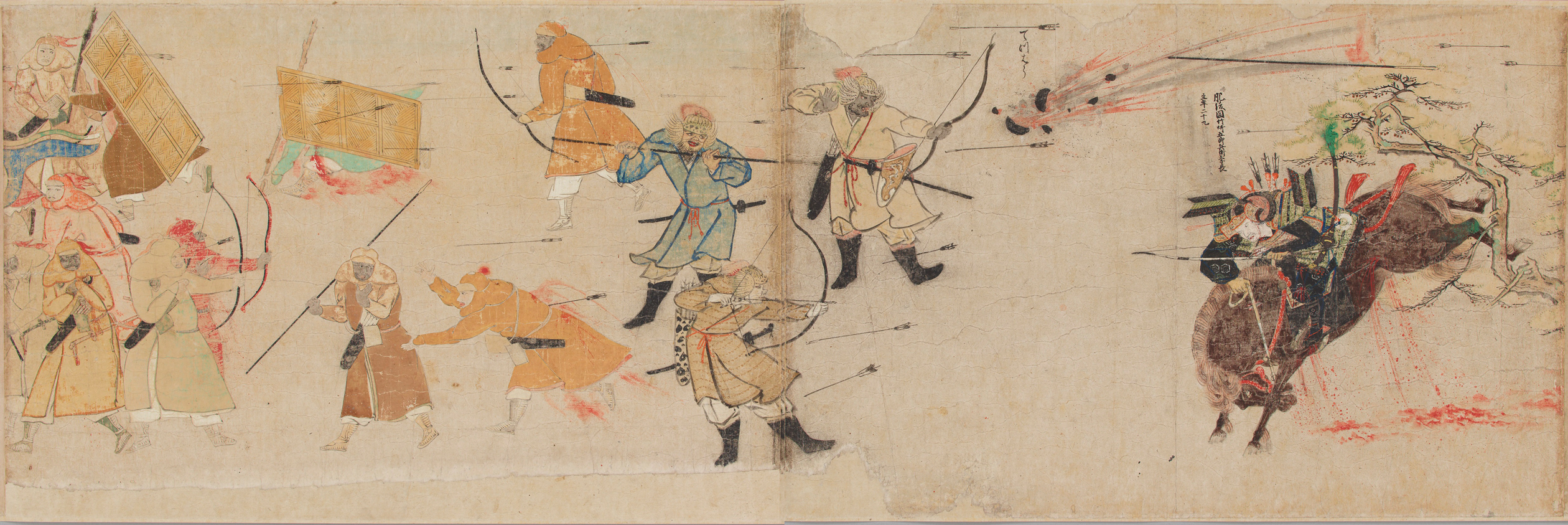After his first attempt for a naval invasion of Japan ended with a freak storm (the “kamikaze”), Kublai Khan, ruler of China under the Yuan Dynasty and Korea by means of the Goryeo, made a second invasion in 1281. Two combined fleets made the journey, the first of 900 ships in June and the second of more than 3,500 ships later in the summer. The initial invaders of June had struggled to make landfall at Hakata Bay, constantly being beaten back by waves of Japanese samurai warriors. At night, the samurai would sneak out in small boats to the fleet and raid, killing as many as they could and setting fires before escaping back into the darkness.
Under such assault, the first fleet retreated to Tsushima Island between Korea and Japan, there meeting with the larger fleet in July and preparing for a full-scale invasion. Clouds seemed to build in the east, and sailors feared another kamikaze, but generals pressed and Mongol-led armies made landfall before a storm could strike. Another vicious battle began for the beach with massive casualties on both sides. Out of sheer numbers, the Mongol force was able to gain control, and Japan became broken. After weathering two days of storms on the safety of land while watching their ships be destroyed, the Mongols continued military conquest.
Over the next three years, the Mongols worked to establish control of the Japanese islands. Forces were continually supplied anew, crushing any rebellion and gradually wearing away the image of the brave samurai. A puppet emperor was installed, giving credence to the new cultural edicts put into motion by the Mongols to strip Japan of its national identity. Over the next century, Japan would become another arm of the Khanate.
In the 1360s, the House of Yuan crumbled from within over intrigue, and Japan, Korea, and conquests in the south won their freedom. Civil war would haunt Japan for the next several centuries, made worse by manipulative Dutch traders selling firearms to any and all sides. The weakened nation would eventually fall to Dutch warships and be declared a colony in 1641, ruling out of Deshima. Colonial wars would divide Europe, and Japan would be handed between the Dutch and British twice, first in 1781 and then again in 1811. After altercations because of trade routes, the powers finally settled with the Dutch holding Java (excluding the British in Singapore) and the British in Japan (excluding the Dutch at Deshima).
During the Victorian era, the Japanese grew attached to British culture and, most importantly, technology. Canals, railroads, and factories grew up throughout Japan, and Kyoto was often joked as being “more English than London.” Japan would serve as an important ally in World War One and again in World War Two against Germany, supplying exceptionally dedicated troops that helped achieve victory in Operation Sledgehammer over the course of 1942-43.
After the war, Britain's empire began to evolve into the looser Commonwealth, and Japan won its independence. Seeing the bloodshed in China with the Communist uprising, Japan remained staunchly capitalist and served as one of the key players in the Korean Conflict, offering up even more troops than the United States. The remainder of the twentieth century would see Japan as one of the most significant economic and military forces in the East, often causing harsh diplomatic difficulties with neighboring communist China. Though there have been international efforts continuously to keep the two apart, it is generally accepted that war will break out between the two with millions of casualties.
–
In reality, the kamikaze did strike before the Mongols could establish a beachhead. Mimicking the first invasion, samurai kept the Mongols and allies from making successful landings, then the storm struck. Contemporaries estimate 9% survival rates for the ships and 80% loss of life, meaning more than 120,000 invaders met their ends either by samurai blade or Divine Wind. Japan remained anti-foreigner for centuries until the coming of Admiral Perry in 1853.

this doesn't seem to be historically accurate with other sources...
ReplyDelete